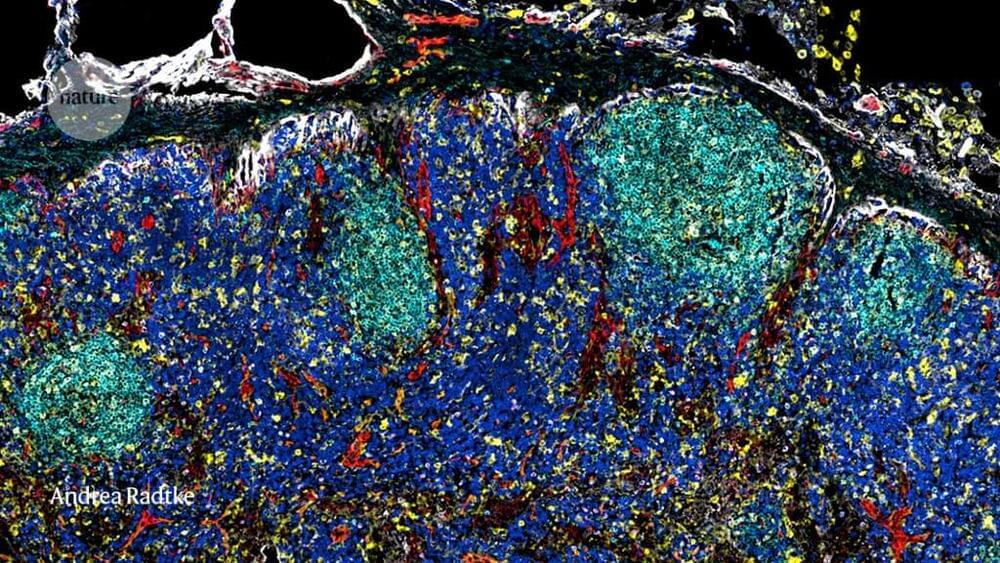Japan is using Augmented Reality to teach children about the dangers of flash floods 🌊 https://bit.ly/3kYclTI


Japan is using Augmented Reality to teach children about the dangers of flash floods 🌊 https://bit.ly/3kYclTI

One explanation for this could be the degree of efficiency of each organism’s response to the damage sustained by its cells during its life, which eventually causes them to age. In relation to this, researchers at the Universitat Oberta de Catalunya (UOC) and the University of Leicester (United Kingdom) have developed a new method to remove old cells from tissues, thus slowing down the aging process.

The first images are now coming through to NASA from this week’s flyby of Jupiter by its Juno spacecraft.
This latest close flyby is the 37th of the mission, but this basketball court-sized spacecraft’s images of the giant planet never cease to amaze.
This week’s images even include a rare photo of Jupiter’s moon Europa.

Beauty quarks are unstable, living on average just for about 1.5 trillionths of a second before decaying into other particles. The way beauty quarks decay can be strongly influenced by the existence of other fundamental particles or forces. When a beauty quark decays, it transforms into a set of lighter particles, such as electrons, through the influence of the weak force. One of the ways a new force of nature might make itself known to us is by subtly changing how often beauty quarks decay into different types of particles.
The March paper was based on data from the LHCb experiment, one of four giant particle detectors that record the outcome of the ultra-high-energy collisions produced by the LHC. (The “b” in LHCb stands for “beauty”.) It found that beauty quarks were decaying into electrons and their heavier cousins called muons at different rates. This was truly surprising because, according to the standard model, the muon is basically a carbon copy of the electron – identical in every way except for being around 200 times heavier. This means that all the forces should pull on electrons and muons with equal strength – when a beauty quark decays into electrons or muons via the weak force, it ought to do so equally often.
Instead, my colleagues found that the muon decay was only happening about 85% as often as the electron decay. Assuming the result is correct, the only way to explain such an effect would be if some new force of nature that pulls on electrons and muons differently is interfering with how beauty quarks decay.
I woke up this morning, saw the COP26 headlines and was so irate I had to share my thoughts.
Please excuse this unplanned video.
I woke to headlines this morning that made me so mad I just had to set up my camera to give my thoughts.
My next videos will be on power, precision fermentation and biochar so keep your eyes open.
And remember the future is NOT someone else’s problem.
Check Out Found And Explained; https://www.youtube.com/c/FoundAndExplained.
Become a Channel member:
https://www.youtube.com/channel/UCMwDeEoupy8QQpKKc8pzU_Q/join.
Support me on Patreon: https://www.patreon.com/HistoryWithKayleigh.
Ancient Structures: https://www.youtube.com/playlist?list=PLyM1QcUGVGdfmvhQKoWzGJnJgQ4BfaplL
Ancient Queens: https://www.youtube.com/watch?v=L-5ENRuFn9g&list=PLyM1QcUGVG…Py&index=1
New Discoveries: https://www.youtube.com/playlist?list=PLyM1QcUGVGdfCySvH9f3ReUXsuPbW0hAU
Fact or Fiction?: https://www.youtube.com/playlist?list=PLyM1QcUGVGdeib_J7to1OuMEa6635OoQo.
#yakhchal #yazd #windcatcher.
How did the ancient inhabitants of the hot Iranian desert keep themselves cool during the intensely hot summers where even being in the shade is very unpleasant?
Well, besides the windcatchers they had in their homes of course, since we spoke about them a while ago.
Think about being in the middle of a hot dry desert, it would be a blessing to be able to drink cold beverages and eat ice cream in the middle of summer to cool off, or to keep your meat, dairy, fruits and other foods fresh for longer periods of time by cooling them.
But I am hearing you asking yourselves… ice?? how on earth would they be able to provide ice in the middle of a hot and dry desert?
The answer to that is simple yet innovative; build a Yakhchal.
We don’t know for certain where the first ice houses were built on the planet, and we aren’t sure about when the first yakhchal was built either but we do know that around 400 BCE the Persian engineers were already mastering the art of storing ice in the middle of the desert, it was already a widespread phenomenon around this time.
This shows that the actual invention of the Yakhchal happened much earlier as you don’t master something by doing it for a short amount of time, but it’s unfortunately unclear for how long.
The practice of storing ice itself was already long established by the time of 400 BCE, we know for a fact that the Mongols were already storing ice for quite some time, although again it’s unclear for how long, but there are accounts of them doing it before 400 BCE.
Ice was mentioned in older texts in Iran from before 400 BCE, but there was no mention of how it was produced, which doesn’t allow scholars to interpret that as yakhchals already being used for very long before 400 BCE, although it is of course hypothesized as I said earlier, you don’t master something by doing it for a short amount of time.
Music; Adrian von Ziegler.

In a wide-ranging interview at the WSJ Tech Live conference that touched on topics like the future of remote work, AI innovation, employee activism and even misinformation on YouTube, Alphabet CEO Sundar Pichai also shared his thoughts on the state of tech innovation in the U.S. and the need for new regulations. Specifically, Pichai argued for the creation of a federal privacy standard in the U.S., similar to the GDPR in Europe. He also suggested it was important for the U.S. to stay ahead in areas like AI, quantum computing and cybersecurity, particularly as China’s tech ecosystem further separates itself from Western markets.
In recent months, China has been undergoing a tech crackdown, which has included a number of new regulations designed to combat tech monopolies, limit customer data collection and create new rules around data security, among other things. Although many major U.S. tech companies, Google included, don’t provide their core services in China, some who did are now exiting — like Microsoft, which just this month announced its plan to pull LinkedIn from the Chinese market.
Pichai said this sort of decoupling of Western tech from China may become more common.

Early in the pandemic, my team spotted something surprising. When people were severely ill with COVID-19 and on a ventilator, the daily rinses of the plastic tubes in their windpipes contained immune cells from the airway. More surprisingly, what was in these airway samples was very different from what was found in the same patient’s blood.
COVID has shown we must study immunity in the whole body — let’s sort the logistics to acquire the right samples.


Fijitsu retrofitted one of it’s clean rooms in a vertical farm. The project was so successful, they discovered they could enter a new market segment and sell the systems themselves. I definately want one.
Like the giant monolith in Stanley Kubrick’s 2,001 this new head of lettuce is simultaneously a product of this factory’s past and the future. Fujitsu is a space-age R&D innovator with sprawling, specialized factories. But several of its facilities, including this one, went dark when the company tightened its belt and reorganized its product lines after the 2008 global financial crisis. Now in the aftermath, it has retrofitted this facilities to serve tomorrow’s vegetable consumers, who will pay for a better-than-organic product, and who enjoy a bowl of iceberg more if they know it was monitored by thousands of little sensors.
Like the giant monolith in Stanley Kubrick’s 2001, this new head of lettuce is simultaneously a product of this factory’s past and the future. Fujitsu is a space-age R&D innovator with sprawling, specialized factories. But several of its facilities, including this one, went dark when the company tightened its belt and reorganized its product lines after the 2008 global financial crisis. Now in the aftermath, it has retrofitted this facilities to serve tomorrow’s vegetable consumers, who will pay for a better-than-organic product, and who enjoy a bowl of iceberg more if they know it was monitored by thousands of little sensors.
A year into the project, Fujitsu is now producing between 2,500 and 3,000 heads of a lettuce a day that sell for three times the normal price: The company is using its hydroponic lettuce farm to showcase its “smart” farming technologies, in the hopes of nurturing a new agribusiness.
The project is the outgrowth of a company-wide reorganization following the 2008 financial crisis, after which Fujitsu decreased its number of product lines from nine to six. Originally built in 1,967 the building where the company is now growing lettuce was once the largest transistor factory in the world. Over the years, Fujitsu expanded, buying up three other buildings and the remainder of the industrial park, bringing its total footprint in the area to roughly 260,000 square meters.